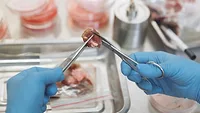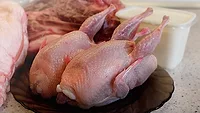FDA Evaluates First Cell-Based Meat Product, Raises No Food Safety Concerns; Believes Cultured Meat Ready for Market in Near Future

Credit: alleksana (alleksana) via Pexels
The U.S. Food and Drug Administration (FDA) has completed its first premarket consultation for cultured meat (also known as “cell-based” or “lab-grown” meat), in response to a submission from company UPSIDE Foods. At present, FDA has no further questions about the firm’s conclusion that its cultured poultry meat products would be safe. UPSIDE foods intends to use animal cell culture technology to take living cells from chickens and grow the cells in a controlled environment to produce cultured meat.
The voluntary premarket consultation is not an approval process. Rather, it means that after FDA’s evaluation of the data and information shared by UPSIDE Foods, the agency has no further questions about the firm’s safety conclusion. Furthermore, FDA has not identified any information indicating that the production process as described by UPSIDE Foods would be expected to result in food that is contaminated by any substance or microorganism that would adulterate the food.
FDA's premarket consultation with the firm included an evaluation of the firm’s production process and the cultured meats produced by the process, including the establishment of cell lines and cell banks, manufacturing controls, and all components and inputs. Potential safety issues associated with UPSIDE Foods’ cultured poultry, which may be mitigated with established strategies, include possible contaminants from the source of the cells, reagents, the environment, materials used, equipment surfaces, or media components.
The cultured meat products are made of Gallus gallus cells, isolated from adult chickens or mid-stage fertilized chicken eggs, with characteristics of myocytes and fibroblasts. After cell lines are established and the cells are cultured, the cells are harvested in the form of sheets of cells that are washed from the surface of the culture vessel into a collection basin, followed by subsequent washing and moisture adjustment in a temperature-controlled environment. Following washing, the harvested material is similar in composition and nutritive value to conventional poultry products.
UPSIDE Foods’ submission describes the identity, production, and safety of a cultured poultry product produced from edible tissues derived from two chicken cell lines. Although cell-based meat production is a new technology, UPSIDE Foods believes that many of the fundamental concepts forming the basis of cell culture technology are rooted in practices that have a long history of safe use in food production. Historical experiences with food fermentation technology, including foods and food ingredients produced from genetically modified microorganisms and plants, are examples of such technologies that have a history of safe use for foods.
UPSIDE Foods' food safety and quality systems are based on FDA regulations for Good Manufacturing Practices (GMPs) and Hazard Analysis and risk-based Preventive Controls for Human Food, codified in 21 CFR part 117, and the Global Food Safety Initiative (GFSI) standard. The food safety plan addresses potential hazards that may be introduced into food during the production process and the preventive controls that are employed to mitigate such hazards (e.g., microbial and environmental contaminants, culture media components, food contact articles, etc.). Prerequisite programs leveraged by UPSIDE Foods to mitigate food safety hazards include, but are not limited to, GMPs, validated sanitation practices, environmental monitoring, supplier approval, control measures, and traceability. The firm also highlighted its supporting programs, including corrective actions, GMP and systems auditing, raw materials and product sampling, hygienic design of equipment, crisis management, and employee training. UPSIDE Foods analyzed and addressed potential microbiological, chemical, and physical food safety hazards, which will be controlled through the aforementioned food safety control strategies, as well as chemical approval and monitoring, a glass and brittle plastics program, and foreign material monitoring.
In addition to meeting FDA’s requirements, including facility registration for the cell culture portion of the process, the firm will need a grant of inspection from the U.S. Department of Agriculture’s Food Safety and Inspection Service (USDA’s FSIS) for the manufacturing establishment. Additionally, the food itself requires a mark of inspection from FSIS before it can enter the U.S. market. As the product comes closer to entering the U.S. market, FDA will be closely coordinating with FSIS to ensure it is properly regulated and labeled.
Looking for quick answers on food safety topics?
Try Ask FSM, our new smart AI search tool.
Ask FSM →
Under a March 2019 formal agreement, FSIS and FDA agreed to a joint regulatory framework wherein FDA oversees cell collection, cell banks, and cell growth and differentiation. A transition from FDA to FSIS oversight will take place during the cell harvest stage. FSIS will oversee the post-harvest processing and labeling of human food products derived from the cells of livestock and poultry.
Advancements in cell culture technology are enabling food developers to use animal cells obtained from livestock, poultry, and seafood in the production of food, and FDA expects such products to be ready for the U.S. market in the near future. The agency states that it is ready to work with additional firms developing cultured animal cell food and production processes to ensure such food is safe and lawful under the Federal Food, Drug, and Cosmetic Act. FDA encourages firms to have conversations with the agency often and early in their product and process development phase, ahead of making any submission to FDA.
The agency is currently engaged in discussions with multiple firms about various types of food made from cultured animal cells, including food made from seafood cells that will be overseen solely by FDA. The agency’s goal is to support innovation in food technologies while maintaining the production of safe food. Human food made with cultured animal cells must meet the same stringent requirements, including safety requirements, as all other food.








